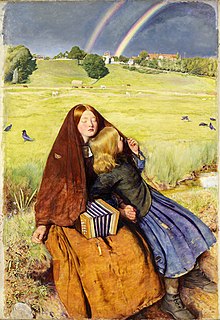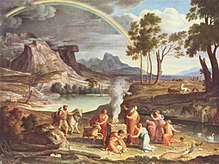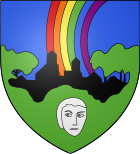|
Rainbows in culture
 The rainbow has been a favorite component of art and religion throughout history. ReligionThe rainbow has found a place in the mythological systems of many cultures. It is sometimes personified as a deity, such as the Greco-Roman messenger goddess Iris, or the Aboriginal Australian Rainbow Serpent. In Albanian folk beliefs the rainbow is regarded as the belt of the goddess Prende, and oral legend has it that anyone who jumps over the rainbow changes their sex.[1] In other cultures it may represent a bridge or an archer's bow. In Judaism and Christianity, the rainbow is associated with God's protection, as it is described in the Book of Genesis (9:11–17) as a sign of the covenant between God and man. ArtRainbows are generally described as very colourful and peaceful. The rainbow occurs often in paintings.[2] Frequently these have a symbolic or programmatic significance (for example, Albrecht Dürer's Melancholia I). In particular, the rainbow appears regularly in religious art (for example, Joseph Anton Koch's Noah's Thank Offering). Romantic landscape painters such as J. M. W. Turner and John Constable were more concerned with recording fleeting effects of light (for example, Constable's Salisbury Cathedral from the Meadows). Other notable examples appear in work by Hans Memling, Caspar David Friedrich, and Peter Paul Rubens.
In contemporary visual art, the rainbow often appears as well, notably in Peter Coffin's Untitled (Rainbow), 2005,[3] and in Ugo Rondinone's Hell, Yes!, 2001.[4] Like many other cultural references to the rainbow, these either emphasize the possible sublimity of the natural world or the cheerfulness, joy, and celebration often culturally associated with a profusion of colors. In 2012, American artist, Michael Jones McKean created a large-scale artwork, The Rainbow.[5] The project created, impart, a fully sustainable prismatic rainbow using thousands of gallons of pressurized harvested rainwater, at times stretching several city blocks in size.[6] HeraldryCoats of arms and insignia depicting rainbows (from top left: Regen, Pfreimd, Bouffémont and 69th Infantry Regiment-NY) In heraldry the rainbow proper consists of 4 bands of colour (Or, Gules, Vert, Argent) with the ends resting on clouds.[7] Generalised examples in coat of arms include those of the towns of Regen and Pfreimd, both in Bavaria, Germany; of Bouffémont, France; and of the 69th Infantry Regiment (New York) of the United States Army National Guard. LiteratureThe rainbow inspires metaphor and simile. Virginia Woolf in To the Lighthouse highlights the transience of life and Man's mortality through Mrs Ramsey's thought: "it was all as ephemeral as a rainbow". Wordsworth's 1802 poem "My Heart Leaps Up" begins:
The Newtonian deconstruction of the rainbow is said to have provoked John Keats to lament in his 1820 poem "Lamia":
In contrast to this is Richard Dawkins; talking about his 1998 book Unweaving the Rainbow: Science, Delusion and the Appetite for Wonder, wrote:
Music
Film and television
FlagsRainbow flags tend to be used as a sign of a new era, of hope, or of social change. Rainbow flags have been used in many places over the centuries: in the German Peasants' War in the 16th century, as a symbol of the Cooperative movement; as a symbol of peace, especially in Italy; to represent the Tawantin Suyu, or Inca territory, mainly in Peru and Bolivia;[8] by some Druze communities in the Middle east; by the Jewish Autonomous Oblast; to represent the International Order of the Rainbow for Girls since the early 1920s, and as a modified symbol of gay pride and LGBT social movements since the 1970s.[9][10] In the 1990s, Archbishop Desmond Tutu and President Nelson Mandela described the newly democratic South Africa as the "rainbow nation", also alluding to its diversity and multiculturalism. Rainbow symbol The rainbow was adopted as a symbol of hope during the COVID-19 pandemic, especially during periods of lockdown. Households worldwide displayed home-made images of rainbows in their windows, often alongside positive messages.[11] The rainbow has been a symbol of ethnic and racial diversity. Various Rainbow Coalition movements have used the rainbow as a metaphor for bringing together people from a broad spectrum of races and creeds.[12] CultureThe Rainbow Bridge (pets) is said to be an afterlife for pets, where deceased animals wait to be reunited with their humans owners once they too pass on. 'Gone to the Rainbow Bridge' and 'helped across the Rainbow Bridge' are used as euphemisms for a pet dying or being put to sleep, respectively. References
|





